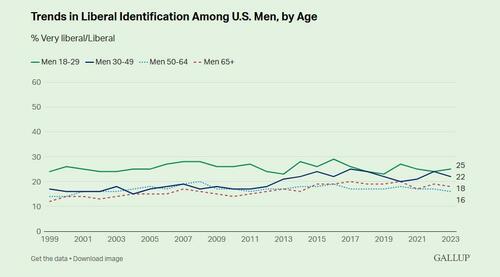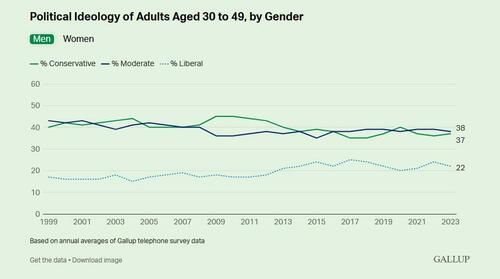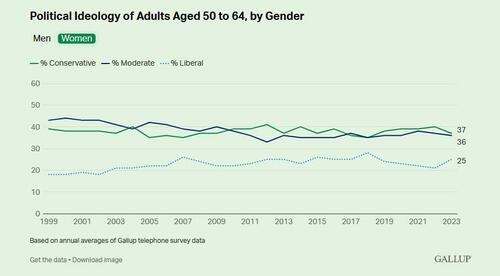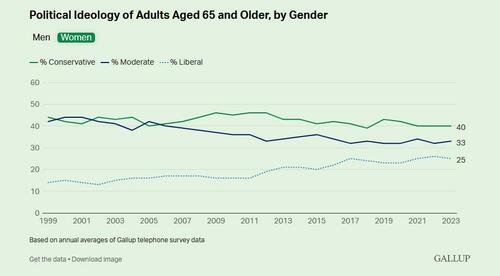US Women Have Become More Liberal, Men Remain Stable: Gallup
By Lydia Saad of Gallup
Highlights:
Young women’s, senior women’s liberal identity up 11 points since 1999
Middle-aged women have also become more liberal, but less strongly
Men’s ideological views have changed less but are slightly more liberal
While notable on its own, the slight leftward shift over the long term in Americans’ political ideology that Gallup has previously documented is even more significant when reviewing the trend among different age and gender groups. Increased liberalism since the 1990s has occurred much more strongly among women of certain age groups, while men’s views have been steadier.
Gallup’s national figures on Americans’ political ideology show the country remains at center-right, with more people identifying as conservative (36%) than liberal (25%) and the rest saying they are moderate (36%). However, the “liberal” percentage has inched up over the past three decades and is currently one percentage point shy of its all-time high. This has occurred as the “moderate” group has shrunk, while the “conservative” percentage has varied narrowly around the long-term average, near 38%.
The following trends detail how these views have changed among each of four age groups of women, and separately of men. The findings are based on annual averages of Gallup’s telephone surveys, generally encompassing 12,000 or more interviews with U.S. adults each year and at least 500 adults in each gender-by-age subgroup.
The analysis looks at people of each age group at the time of the survey rather than tracking each age cohort over time. This allows for answering questions like, “How do the views of 18- to 29-year-old women today compare to women of the same age a decade or two ago?”
Liberal ID Has Increased Most Among Young and Senior Women
Women of all age groups grew more likely to identify as liberal between 1999 and 2021 before drawing back slightly from that position since then. But the steepest increases in liberal ID occurred among women at either end of the age spectrum.
From 1999 to 2013, about three in 10 women aged 18 to 29 consistently identified as liberal, after which the figure rose (a bit unsteadily) to 44% by 2020. The percentage liberal receded slightly to 41% in 2022 and 40% in 2023. The resulting 11-point increase in young women’s liberal identification since 1999 has made what was already the most liberal subgroup of women even more liberal.
Fourteen percent of women aged 65 and older identified as liberal in 1999, but this rose to 21% by 2013 and 25% by 2023, also an 11-point increase overall. Senior women in 1999 were the least liberal female age group, whereas today, they are as likely as middle-aged women to identify as liberal.
In contrast, liberal identification grew just six points between 1999 and 2023 among women aged 30 to 49, from 22% to 28% (after declining from a peak of 36% in 2018). The overall increase was a similar seven points among those aged 50 to 64 -- from 18% in 1999 to 25% in 2023.
Men’s Liberal Ideology Stable by Comparison
The trend in men’s self-description as politically liberal looks relatively stable compared with women, but liberal identity has increased modestly among two age groups of men.
There has been a five-point increase since 1999 in the percentage of men aged 30 to 49 identifying as liberal, from 17% to 22%, and a six-point increase, from 12% to 18%, among men aged 65 and older. At the same time, there has been essentially no long-term change among men aged 18 to 29 (up one point since 1999) or 50 to 64 (up two points).
Fewer men in each age group today identify as liberal than do their female counterparts, but at 15 points, the gap is widest among those aged 18 to 29 (40% of women vs. 25% of men). This contrasts with a six-point difference between women and men aged 30 to 49 (28% vs. 22%, respectively), a nine-point difference between those aged 50 to 64 (25% vs. 16%), and a seven-point difference for those aged 65 and older (25% vs. 18%).
The full ideology trends for each age group among men and women are provided below.
Ideology Among Adults Aged 18 to 29, by Gender
From 1999 to 2016, women aged 18 to 29 were most likely to identify as politically moderate, even as the percentage identifying as liberal was gradually rising. Between 2017 and 2019, the groups were represented nearly equally among young women, after which the liberal share became the plurality.
Conservatism has mostly declined among 20-something women since about 2012. However, after reaching an all-time low of 16% in 2020 and 2021, the share of this group identifying as conservative has risen back to 21%. That still represents a decline in conservatism among young women over the long term, while their liberal identity has expanded.
Switching to men aged 18 to 29, this group has been historically most likely to identify as politically moderate. In contrast, about three in 10, on average, have identified as conservative and about a quarter as liberal. In 2023, the figures were 44% for moderates, 29% for conservatives and 25% for liberals.
View the trends for both men and women by clicking each label toward the top of the chart below.
Ideology Among Adults Aged 30 to 49, by Gender
Women aged 30 to 49 have consistently identified as politically moderate more than anything else, but since 1999, the percentage identifying as conservative has edged down while the percentage liberal has increased. However, those trends peaked in 2018 and have since diminished a little. Today, 40% of 30- to 49-year-old women describe their political views as moderate, similar to the 43% for women in that age group in 1999. Meanwhile, the percentage conservative is five points lower today, at 30%, and the percentage liberal is six points higher, at 28%.
Men in the 30-to-49 age range have, over time, shown the most affinity for the conservative and moderate labels, and in roughly equal measure, while a smaller segment has identified as liberal. However, the liberal share of 30- to 49-year-old men is five points higher today than in 1999, while the percentages moderate and conservative have each declined slightly.
Ideology Among Adults Aged 50 to 64, by Gender
Most women aged 50 to 64 in the past 25 years have self-defined as either conservative or moderate, while fewer have identified as liberal. However, the proportions conservative and moderate have diminished slightly as the percentage liberal has increased. Liberalism was highest among 50- to 64-year-old women in 2018 when it reached 28%. Today, 25% in that age group describe themselves as liberal.
Men aged 50 to 64 have been predominantly conservative over time, although never at the majority level. Moderates consistently rank second among this group, while liberals have ranked third at a much lower level.
Ideology Among Adults Aged 65 and Older, by Gender
Liberal identification has increased significantly over the past quarter century among women aged 65 and older; nevertheless, this has been and continues to be the most conservative-leaning age group of women, with 40% identifying as such today. This contrasts with 37% of their female counterparts aged 50 to 64, 30% of those aged 30 to 49, and 21% of those aged 18 to 29.
The 12-point increase in liberalism among senior women in 1999 versus today occurred as the percentage identifying as moderate declined by nearly the same amount. Meanwhile, the percentage conservative mostly varied between 40% and 46%.
The trend in political ideology is similar among senior men, with the percentage liberal increasing since 1999 and the percentage moderate declining, while the dominant conservative category has generally remained close to 50%.
Bottom Line
In contrast to Americans’ party ID, which has swung from years of strong Democratic advantages to years of partisan parity or slight Republican leads, their political ideology has been more consistent. From the start of Gallup’s regular measurement of ideology in 1992, the largest segments have been conservative and moderate, while liberals have constituted the smallest group. However, within that framework, the increase in the percentage identifying as liberal, from 17% in 1992 to 25% today, is notable.
The trend in ideology by age group within each gender shows that this increased liberalism is largely the result of stronger-than-average pro-liberal shifts among 18- to 29-year-old women and women aged 65 and older. The former represents fundamental differences in the belief systems of women entering adulthood in the past decade versus in prior decades. By contrast, the change among senior women may be more about generational replacement, with formerly middle-aged women bringing their slightly more liberal attitudes into their golden years.
Meanwhile, the politics of men have either become slightly more liberal (as seen with the 30-to-49 and 65-and-older age groups) or haven’t changed (as with adults aged 18 to 29 and 50 to 64).
Thus, a widening of the ideological gaps between men and women over time has been due to women becoming more liberal at a faster rate than men, rather than women and men moving in different ideological directions.








